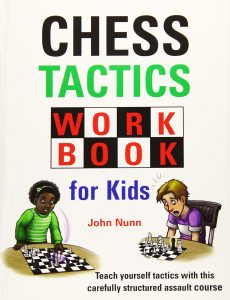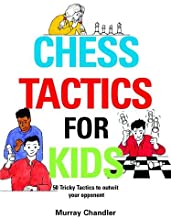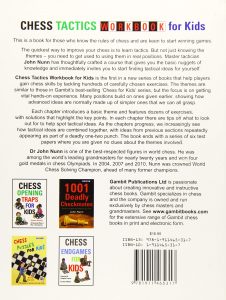Chess Tactics Workbook for Kids : John Nunn

John Nunn has written around thirty books on chess and many of these are some of the finest chess books published in any language : Secrets of Pawnless Endings (1994, Batsford) easily is a candidate for the all time list. John is a director of Gambit Publications Ltd. together with Murray Chandler and Graham Burgess.

Chess Tactics Workbook for Kids is the sixth (a seventh and eighth are scheduled for January 2020 publication) in a highly successful series of “for Kids” books. Indeed, we recently reviewed Chess Opening Traps for Kids. The Workbook theme is likely to be extended other “for Kids” style books from Gambit Publications.
This workbook is a follow-up to the original (2003) and much liked Chess Tactics for Kids by Murray Chandler :

Chess Tactics Workbook for Kids is robustly (!) hardbound in a convenient size such that weights are not need to keep it propped open (unlike some A5 paperbacks) meaning studying with this book is more convenient than with many books. The layout and printing is clear (as you would expect with Gambit) with numerous diagrams at key moments in each, relatively short, game. In essence, players under 18 (for whom this book is intended) will find it easy to dip in out of and it can be used without a board (although BCN and most chess teachers and coaches would always recommend following each game on a “proper” board).
As you would expect with Gambit, the notation is English short form algebraic using figurines for pieces. A previous criticism (ibid) has been addressed in that each diagram has a symbolic “whose move it is” indicator. Each diagram does have coordinates which are very welcome for the younger junior reader.
The book is divided into 13 chapters as follows :
- Fork
- Pin
- Skewer
- Deflection and Decoy
- Discovered Attack
- Discovered and Double Check
- Removing the Guard
- In-Between Moves
- Trapped Piece
- Pawn Promotion
- Opening and Closing Lines
- Forcing a Draw
- Test Papers
Chapters 1 – 12 each contain a description of the type of tactic that is subject of the chapter followed by 20 – 40 exercises for the reader followed by a set of more challenging “Tougher Positions” and then, interestingly, by a set of “Does the Tactic Work ?” exercises. We appreciated the latter especially since this appears to be a novel feature. These are excellent blunder prevention tests since they help to slow typical impetuous juniors down who often move first and then engage their brain.
It was clear when working through the easier set of exercises that the author had thought carefully about their sequence since the reader should (we did for sure !) notice the level of difficulty increasing slowly but surely. The solutions are remote from the puzzles nicely avoiding the “accidentally seeing the solution” issue one gets with lesser books. The solutions themselves are clear and concise and instructional in their own right.
Here is a particularly satisfying example (we thought so anyway !) from the Skewer chapter (Tougher Positions #23) *solution at bottom of this review
We particularly enjoyed the chapters on “Trapped Piece” and “Forcing a Draw” as these are less usual to find in books of this kind.
Here is a pleasing (well, we liked it here in the BCN editorial office) example (#30) from the “Does the Tactic Work?” section of the skewers chapter :
@and the solution is at the foot of this review
We enjoyed working through the chapters and emerged with a feeling of attending a mental gymnasium : exhausted but refreshed.
Chapter 13 (“Test Papers”) puts all of your newly learnt skills to a full and proper test since there are no themes, hints or clues of what to do : just like a real game !
One negative comment we would make concerns the cover. “Never judge a book by its cover” we are told and you might look at this book cover and think it was suitable for say primary aged children. We would say not but we would suggest it suitable from secondary aged children. We would say strong juniors from 12 upwards would read this book and enjoy it.
As we previously mentioned in our review of Chess Opening Traps for Kids, The title and cover might, perhaps, put off the adult club player market. However, the content is totally suitable for adult club players upto say 150 ECF or 1800 Elo.
In summary, we recommend this book to any junior or adult who wishes to improve their tactical vision and results. It makes an excellent stocking filler for young players and the young at heart !
John Upham, Cove, Hampshire, November 11th 2019

Book Details :
- Hardcover : 128 pages
- Publisher: Gambit Publications Ltd (22 July 2019)
- Language: English
- ISBN-10: 1911465317
- ISBN-13: 978-1911465317
- Product Dimensions: 17.8 x 1.3 x 22.9 cm
Official web site of Gambit Publications Ltd.

*solution to Skewer exercise #23 : “Normally this material would lead to a draw, but White can win with a brilliant tactical idea : 1.Bd6!! (the only defence to the threat of 2.Qd3# is to take the bishop) 1…Qxd6 2. Qd3+ Kc5 (2…Ke5 3.Qg3+ is a mirror image) 3.Qa3+ and the queen falls.”
@solution to Skewer exercise #30 : “It seems impossible to save the game because after both side promote White has a skewer, but there is a miraculous defence : 1…g2 2.c8=Q g1=Q 3.Qc5+ Ke2! and further checks don’t help White, while after 4.Qxg1 Black is stalemated.”
